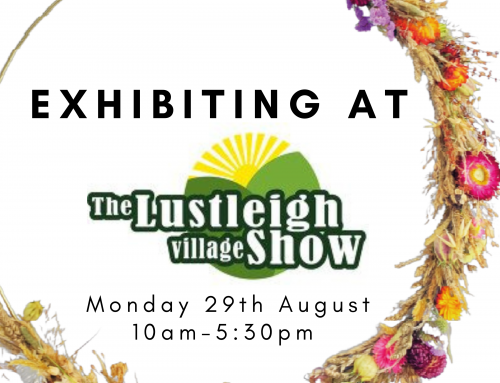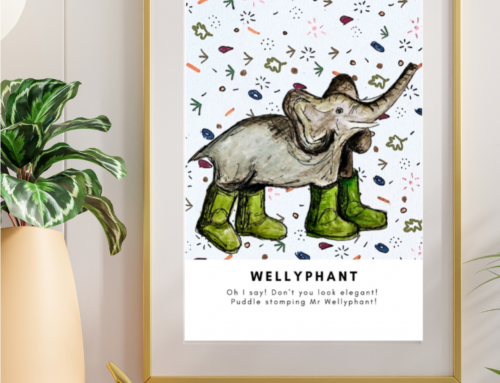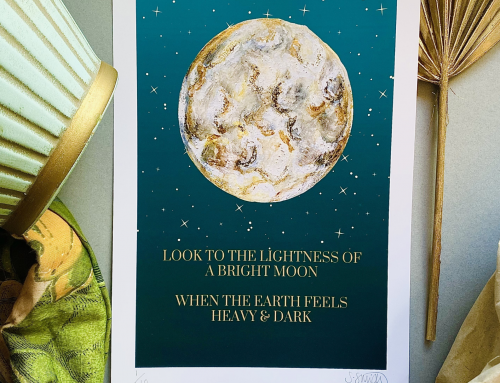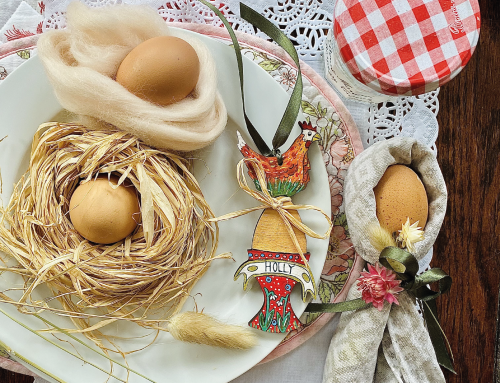Beginning a Small Creative Business
I was recently asked to offer some advice on how to turn a hobby into a business & I thought, the best thing to do was to write about my own experience. I can only offer some guidance based on how I’ve found taking my own hobby and building a business from it. Please take from it what feels right and the bits that don’t sit well, feel free to chuck!
- I found something I love. I discovered painting by chance after an accident and immediately fell in love with it. Prior to this the last time I had painted was back in school, where art never felt like a joy, more a task as part of my week. Suddenly discovering art again was like someone had switched the light on. Not only did it give me the space to be creative but the ways in which it helped my mental health was something I can’t quite put into words. Something that was mine, not anyone else’s. As a busy mum and in the throws of running other businesses with my husband I rarely had something that was just mine. I suddenly found it. I fell in love. I genuinely believe that doing something you love, that gives you joy and makes you feel more yourself than anything is key to building what could be a ‘successful’* business. If the starting place is joy, then that’s an incredible foundation to build upon. * The word successful irks me. Success is different to everybody. Everyone has their own definition of what success is – and if you don’t know what it means to you yet, that’s ok too. It’s taken me a while to work out what success means to me. For me, it will never be about financial reward (though the reality is that we all have to pay bills and eat!). I write this from the privileged position of having a few years under my belt to grow my business, but success for me is about balance. I love what I do, but I don’t want my business to run me ragged, I want to have time to be able to take a day off, to pick my kids up from school, to be flexible, to play, to create, to make joyful things that make people smile. That’s it. Simple.
- I began slowly. My accident meant I spent a year of my life on the living room floor. I had no choice in that. If you’re reading this and you have a full time job and want to make the leap to change your career then start slowly. Build up that side hustle. Find the thing that gives you joy and do it. You don’t need to make any commitments or changes yet, but absolutely tend to that side hustle and build it. I had all the time in the world to begin my business, because I couldn’t physically move! I had lots of thinking time and the desire to get better and do something different. I spent time enjoying making for myself, no one else. I never intended to make a business nor change career but what happened was the more I began to explore and play with process, the more friends and family would say “Oh I LOVE that, can you make me one?!” It really snowballed from me finding my creativity and finding my own style. It’s something that continues to evolve and I tend to lead with my heart when I’m thinking of a new body of work. I started by making a Facebook page for my art, which was my first ‘ballsy’ way of putting myself ‘out there’. It felt scary, it felt daunting, it felt way out of my comfort zone but it did give me a kick in realising that other people, not just people I knew wanted to buy my work. My friends will tell you I’m not very technical – I had no clue about how to make a print from my work. I actually began with using a local printers to help me initially get a small print range of 12 designs which they copied from my originals. Looking back the designs were pretty weak – but they were my starting point. I learnt pretty quickly that buying a set quantity of new designs is a little foolish as you have no idea what people will like, nor if they’ll sell at all. As it turned out some didn’t sell at all. However, three of those first designs still sit on my website today and have been some of my more popular prints. I moved pretty quickly from using a local printer to photographing my own work and uploading them to an online printing company. The benefit of this at the time was that I could take an order and then request that amount. It meant I was way more savvy with stock control and it enabled me to build up a picture of what customers liked. Just over a year ago I decided to invest in my own printer (she’s called Karen if you’re wondering?!) and she’s been a game changer. It’s meant that I can print to order, I’m not reliant on anyone else and I can control what’s happening ‘in house’.
- I asked for help. Once I had my initial twelve designs, I thought right, what next?! I needed to put my work ‘out there’ and realised that in terms of social media I should probably get a business Instagram account. Personally I was late to the Instagram party and had no clue what to do but friends kept telling me, it’s visual, it’s great for creatives and you’d be a right one if you didn’t. So I did. In the early days customers would direct message me asking to buy a print and I’d then email them an invoice. Although I was slowly attracting customers, it was a really laborious way of making sales. I needed a website and one that I could then pinpoint my social to. But, I had zero clue about setting up a website!. I had toyed with the idea of putting work onto Etsy, but for some reason convinced myself it was oversaturated. I know a lot of maker friends have wonderful sales through Etsy, but from the start I wanted to set out my stall and the challenge of putting a website together felt like the perfect thing to define my brand* So I asked for help and found an amazing fella who was able to help me build the website and who was incredibly patient teaching me how to create content boxes, upload imagery and take control of a website shop. To this day, it’s still me behind the website, uploading products and tweaking things. I don’t pretend to be an expert – I’m really not – but it’s good to have control over that aspect of the business, knowing that there’s help out there if I need to ask. It’s also important to remember that no question is a silly question, even if you feel right silly for asking it!
*I hate the word brand – it feels so impersonal and icy cold. But I had to begin thinking of what I was doing as a brand. I needed to step outside of my own head and evaluate what my key values were, how I wanted to appear, what my work was attempting to do and recognise a potential customer base. I knew that to attract customers, I needed to be completely genuine and transparent so in order to do that I had to really know what it was I wanted my business to say. After all, it’s an extension of me and what I love doing.
- I embraced the ICK – I did my research – in the early days I didn’t have a clue about how to price my work. I found pricing awkward – in fact anything numbers related frightened me. Each piece is different, some work takes me longer, some is bespoke, hand painted, other early pieces were original canvasses and larger paintings. Where to start? Firstly I logged my time – how long does it take to produce? I also referenced material costs and this gave me an overall picture of the labour and costs involved. From this, I then researched similar products on the market – I began with looking at art prints. What is a general art print priced at? What size is it? Is my work comparable? If I sold at ‘x’ would that cover my time, my labour and actually pay me as a business owner? You need to price your work with these factors in mind. It’s also worth noting it will always feel a little icky pricing your work because it’s YOUR work and sometimes it’s difficult to step outside of that. It’s worth chatting to people who know you, where you can have an honest accountable chat and discuss how much someone would be willing to pay. BUT it’s also important to know that it’s YOUR work and only you can price what you think its worth. One of the best things to help me factor my finances was to get a separate bank account. This sounds like such a simple thing to do, but it’s amazing how many small biz owners in the early days don’t. Get a business account and make sure you are paying yourself (!) Especially if this small business is still in the side hustle era. Alternatively, you may not be able to pay yourself yet, but it’s important to have that thought in your head and to know that as and when you can afford to, you are keeping business separate from personal finances.
- Events – I mean EVENTS?!!! I haven’t had one of those for a long time! BUT if you really want to push yourself I’d totally recommend applying for a local craft event or makers market. When I had my 12 designs, I applied for a local market and the experience was invaluable. It was the first opportunity to put my designs together, to see what my small business was potentially saying to a customer and it made me realise I needed to knuckle down and work harder! I didn’t have a card machine then, I had a small float, I was in a corridor next to the toilet BUT my goodness my first market was such a thrill. It gave me chance to talk to a potential customer base and enabled me to make my first real life sales. If you’re just starting out, feel the fear, apply and enjoy it. Remember it’s not all about sales, it’s about connecting with people and having an opportunity to share what you’re about. I’ve made so many maker friends at events and it’s such a community. I’ve never known anything quite like it.
- Be prepared to change things up – Creatively I’ve found that I make lots of different things and I never want to feel hemmed in to a particular style. I sketch a lot, I write down ideas and purposely go back to what inspires me. My work is always grounded in the British countryside, but the way it spills out is seemingly different as I go along. I think what I’m trying to say here, is that it’s important to try lots of different things and to feel confident enough to explore newness. New things are always scary, but as a creative its part of the process. Not everything is a final product. Not everything should be put on a website or a social page. For me the real joy of making is in the process towards that final thing. However, process doesn’t always mean there’s an end result. Be prepared to go with your gut and change things up as and when you feel they’re right. It’s also totally normal to have days, weeks, months where you don’t feel inspired/you don’t make anything. But hey, you’re not a machine and you shouldn’t have to be making newness all the time. One thing to be aware of is to stay in your own lane. It’s so easy to look at what others are doing and to compare what you’re doing. But I’ve found this isn’t helpful, it makes you feel awful and you can easily move away from what you’re doing. When you feel this happening, stop looking over at what they’re doing ‘over there’ and focus on your own lane.
- Have accountability – Have that someone in your life who you can talk to and bounce ideas off. As a small business owner I work on my own and that can be awesome and lonely all in the same breath. I can often get bogged down or distracted but find that If I share the feels with a trusted counterpart it really helps me find clarity. When I was working on my book, I sent out ‘final’ copies to trusted friends and colleagues. People who would be brutally honest, wouldn’t care about hurting my feelings and people that I’d trust to make observations. Their insightful comments and their honesty really helped inform some of the decision making behind the final book and having them to bounce ideas off really helped. This should be true of your day to day. Talk about what you’re doing, chat about the stumbling blocks and in doing so you’ll probably be able to get rid of the barriers just by talking to someone who trust.
- Shrug off the awkward megaphone – As a small business owner we are all the components of every aspect of our business. We’re the makers, the marketeers, the accounts, the PR, the teamakers and the face of the business. We literally do everything! So please shrug off what can feel like a really awkward megaphone. We all know that tooting our own horn, or shouting into a megaphone feels awkward as arse, but who else is going to do it?! Some of you who follow me on social media may know about the character of Tess and Janet (Tess, is my mum – who bizarrely isn’t even called Tess?! – and she helps out during busy periods. Janet is a completely made up assistant who does all the jobs I don’t’ want to – or rather Janet is the person I blame for when someone cocks up an order!) My point is that when you work alone, you are solely responsible for what gets done. We all relish the fun jobs, but the boring, awkward ones can always be put at the bottom of the list, because quite frankly there’s no-one else to wang them to the top! SO, shout about what you’re doing – use the megaphone and don’t feel awkward about it! Who you are and what you do is unique and if someone doesn’t like that, then that’s ok – we can’t make everyone happy. BUT we can think positively about what we do and affirm it by being confident enough to hold up the megaphone.
- Re-visit – As part of an evolving business it’s important to revisit past work, things you’ve done and to see whether they still fit with your vision going forward. Sometimes I’ve dug out old work that I haven’t used for anything and it’ll inspire something new. Sometimes revisiting your website to see how it looks and whether it still feels like ‘you’ can help. Taking the time with a brew in hand to look at your business with glasses on can do wonders for where the next step may take you. Could you improve your sustainability footprint? Could you make it easier for the customer to purchase something? Could you decrease your Instagram scrolling for well-planned scheduled content? You get me. Revisiting aspects of the business, even if you tackle one thing a month will help.
- Make time for you – When you live and breathe your small business, you are so immersed in it it’s difficult to step away. But really try to! I’m not the best role model for this as I’ve recognised I need to step back more than I do, however, this goes full circle to what success means to you from my first point. Success for me is about balance. I love what I do, but I don’t want my business to run me ragged, I want to have time to be able to take a day off, to pick my kids up from school, to be flexible, to play, to create, to make joyful things that make people smile. That’s it. Simple.
I hope this has helped you in some way. If you’re an existing small business owner, I’m virtually high fiving you and your business. If you’re about to create a side hustle then go for it. If you’re about to make the switch to making your small business your full time job, go for it!
There really isn’t anything stopping you, because even if you begin slowly, you’re beginning.





